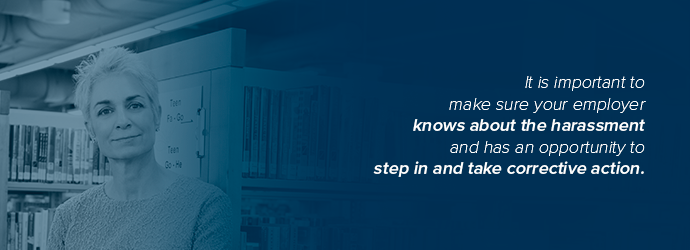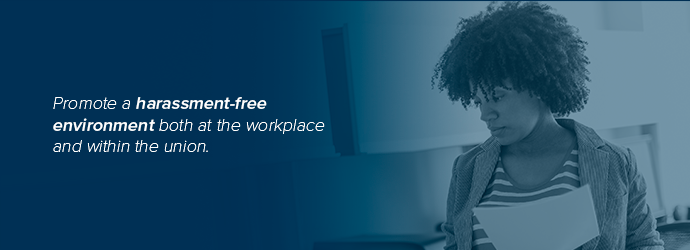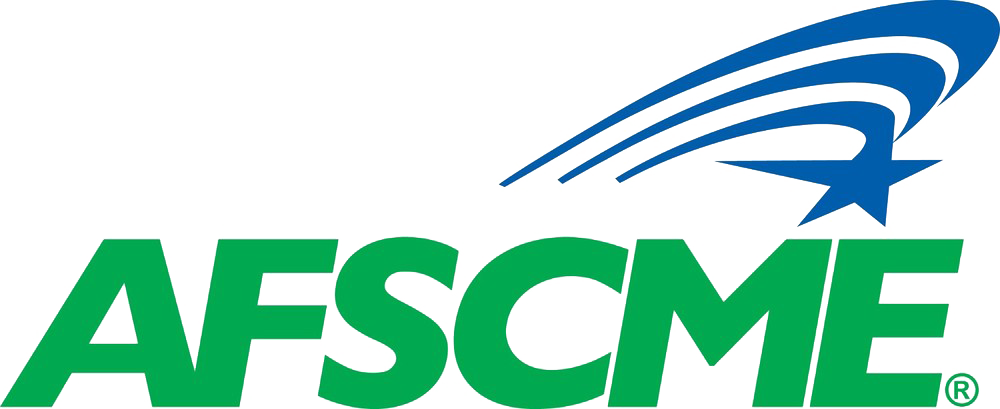Sections of this guide:
- What Is Sexual Harassment?
- Sexual Harassment Is Against the Law
- What You Can Do to Stop Harassment
- What the Union Can Do
- Sample Contract Language/Policy
Everyone deserves a workplace free of sexual harassment. The members of AFSCME have devoted our careers to serving our communities, and we expect respect on the job.
Do you have questions about sexual harassment? What's the definition? How can you address harassment in the workplace? What can your union do to help? What are you rights?
Our guide to preventing and combating sexual harassment is here to help. Read below to understand more about what you can do to make sure you have the harassment-free workplace you deserve.

Harassment of an employee or applicant "because of" their sex is unlawful.
Sexual harassment is unwelcome behavior that affects employment, unreasonably interferes with work performance or creates a hostile, intimidating or offensive place to work.
Harassment behavior includes:
- Unwelcome sexual advances,
- Requests for sexual favors, or
- Verbal, visual or physical harassment of a sexual nature.
The victim can be anyone, of any gender or gender identity. Any person may be affected by the offensive conduct, even if not that person is the intended focus of the harassment.
The harasser may be of the same or different sex and may be a supervisor, an agent of the employer, a co-worker or a non-employee.
The harassment may occur at work or off the work site.

Sexual harassment behavior need not involve sex; it takes many forms, including (but not limited to) the following:
- Verbal Conduct
Using vulgar language, making lewd comments, or using sexual insults, jokes or innuendo, making sexual advances or requesting sexual favors; - Non-verbal Conduct
Using sexual gestures, displaying or sending sexually suggestive or pornographic pictures or objects, including posts on social media; - Unwelcome Physical Contact
Touching, pinching, patting, brushing against the body, kissing, or cornering or impeding another person's movement, and criminal behavior including sexual assault and rape.
Non-sexual conduct directed at a person because of their gender is also unlawful sexual harassment if it is severe and pervasive, such as a supervisor continually insulting a woman's work product and repeatedly telling her a man could do her job better.
Important Note:
Even if the conduct doesn't rise to a level that is considered unlawful (teasing, an offhand comment or isolated low-level incident), it still may violate an employer's harassment policy or the collective bargaining agreement and, if so, should be reported.
Retaliation for Complaining About Harassment Is Against the Law
Your employer (and your union) cannot retaliate against you for reporting harassment, participating in a harassment investigation or lawsuit or opposing harassment in the workplace.

Title VII of the 1964 Civil Rights Act
The Equal Employment Opportunity Commission and the U.S. Supreme Court have determined that sexual harassment on the job is sex discrimination and violates Title VII of the Civil Rights Act. The EEOC and the courts have determined that there are two types of sexual harassment that violate Title VII.
The first, quid pro quo harassment, occurs when a worker is subjected to unwelcome conduct of a sexual nature and submission to that conduct is made a condition of employment. In cases of quid pro quo harassment, a worker's rejection of harassing conduct (for example, rejecting a sexual advance or refusing to tolerate verbal or physical sexual conduct), leads to an adverse employment action against the victim, such as termination of employment or an unfavorable transfer.
The second type of harassment is known as hostile work environment harassment. The "hostile work environment" harassment theory was adopted in Meritor Savings Bank v. Vinson, 477 U.S. 57 (1986). In the Meritor case, a female bank employee claimed that a bank vice president repeatedly demanded sexual favors, exposed himself to her and forcibly raped her on several occasions. A unanimous Supreme Court found that even in cases where no tangible employment action was taken against a worker, the employer was liable if the harassing conduct was severe and pervasive and the employer knew or should have known of the harassment and failed to take prompt action to stop and remedy the harassment.
Several other cases decided since Meritor have added clarity to the question of when an employer is liable for harassment. In Harris v. Forklift Systems, 114 S.Ct. 367 (1993), the Supreme Court determined that it was not necessary to show psychological injury in order to prove that sexually offensive conduct created a hostile work environment. Instead, the standard is whether the conduct creates a hostile environment in the mind of a reasonable person. The factors considered include the frequency and severity of the conduct, whether it was humiliating or threatening and whether it interfered with the worker's job performance, discouraged the worker from remaining on the job or advancing in his or her career.

In Burlington Industries, Inc. v. Ellerth, 524 U.S. 742 (1998) and Faragher v. City of Boca Raton, 524 U.S. 775 (1998), the Supreme Court determined that an employer is strictly liable (automatically responsible) for a supervisor's conduct if a tangible employment action (a significant change in employment status) was taken against the victim of the harassment, including, for example, termination of employment, a demotion, or a cut in pay or benefits. In Vance v. Ball State University, 133 S.Ct. 2434 (2013), the Supreme Court also made it clear that a supervisor is any employee who was "empowered by the employer to take tangible employment action against the victim." In cases where no "tangible employment action" was taken against the victim, an employer may avoid liability if it affirmatively shows that it took reasonable care to prevent and promptly correct harassment and the victim failed to use an employer's complaint process or make other efforts to avoid the harm.
While these court decisions help to hold employers accountable for sexual harassment, there is no question that sexual harassment is a continuing and serious issue for many workers. In the fiscal year 2015, almost one half of the 28,000 harassment charges received by the EEOC included allegations of sexual harassment.
(See the EEOC's Select Task Force on the Study of Harassment in the Workplace (6/20/16))
Workers and unions, by making sure employers carry out their responsibilities to provide a harassment-free workplace, will help ensure a safe and healthy work environment for all.
"Workplaces that tolerate harassment have more of it. And workplaces that are not tolerant of harassment have less of it. "

If you feel comfortable doing so, object — as soon as possible — by telling the harasser to stop.
If objecting doesn’t stop the conduct and your workplace has an anti-harassment policy or handbook, follow the reporting and complaint steps in the policy.
Or, talk to your union steward, staff representative or one of your local union officers to find out if there is language in your collective bargaining agreement that may help, and file a grievance.
If there is no policy or contract language, you should still talk to a supervisor, manager or a human resources professional at your workplace, or talk to your union steward or other union representative.
It is important to make sure your employer knows about the harassment and has an opportunity to step in and take corrective action.

When the employer takes action to address the harassment, it shouldn’t adversely affect you. For example, the employer may propose transferring you away from the harasser. If the new job is in an inconvenient location, or would adversely affect your seniority rights or promotional opportunities, you can ask that the harasser be transferred, instead.
If your employer fails to address your complaint or takes an adverse action against you for filing a complaint, talk to your union or contact the federal EEOC or state agency.
You also have the option of filing a charge of discrimination with the federal EEOC or state Fair Employment Practices agency; be aware that there are time limits for filing a charge (180 or 300 days depending on where you work).

Promote a harassment-free environment both at the workplace and within the union.
If you observe harassment in the workplace, whether or not the victim complains, make efforts to stop it and put management on notice of the harassment; it is the employer’s responsibility to provide a harassment-free environment. Telling the supervisor, “Joe is really giving Mary a hard time,” or “things are getting out of hand; we have a potential sexual harassment problem,” will help management do something before the problem escalates.
Be sure that the employer has an anti-harassment policy. If not, take steps so the employer develops an anti-harassment policy and communicates it effectively to employees.
Establish an anti-harassment policy through local and council resolutions and distribute it to the membership.
Educate members with a clear explanation of prohibited conduct and include examples with speakers, workshops and literature.
Encourage members to speak up about harassment: “If you see something, say something.”
Choose a steward who will be comfortable handling harassment issues and train him or her on how to handle sexual harassment grievances.
Ask for advice from the council representative, business agent or local officers. It is sometimes helpful to have someone from the outside assist with harassment issues.
If the employer provides anti-harassment training, get union officers, representatives and members included or provide union-sponsored training.
If the employer is conducting an investigation that involves union members, make sure members are aware of their right to representation.
Union members may wish to seek relief through federal and state anti-discrimination laws and the agencies that enforce those laws.

Negotiate anti-harassment contract language that emphasizes the employer’s responsibilities to:
- provide a harassment-free workplace,
- prevent harassment,
- encourage reporting,
- provide a confidential (to the extent possible) complaint process free of retaliation with multiple, accessible avenues to complain,
- promptly, fairly and effectively investigate and resolve all complaints with immediate and proportionate corrective action,
- train and inform workers and supervisors of policy against harassment and complaint procedures.
See below for sample language on sexual harassment negotiated by an AFSCME local.
When the union learns about harassment, act to protect the member who has alleged harassment. Make sure the member is aware of any existing employer complaint processes, offer support, investigate and file appropriate grievances or complaints.
If a sexual harassment complaint is filed by a member alleging harassment by another member, to the extent possible, the complainant and alleged harasser should be represented by two different stewards.
A member who is disciplined or discharged for having engaged in harassment is entitled to representation, upon request. The union should conduct a fair and impartial investigation as to whether there was just cause for the disciplinary action or dismissal.
This guide is not a substitute for, and should not be construed as, legal advice.

AFSCME contracts that include sexual harassment clauses address the issue in different ways.
In some contracts, the employer has a duty to take affirmative steps to provide a harassment-free environment, but require an employee to use a complaint procedure outside of the collective bargaining agreement. In some of these examples, the union has the right to participate in the external complaint procedure on the victim’s behalf. In other contracts, employees are permitted to use the regular grievance procedure to pursue sexual harassment complaints.
While not necessarily model language, below is an excerpt of a sample of contract language and policy that AFSCME has negotiated. The sample includes several elements that negotiators may want to consider. The sample included the definition of sexual harassment which was edited out to avoid redundancy. It is recommended that sexual harassment be defined in the contract or by reference to the EEOC definition.
Sexual Harassment Policy
Purpose
To ensure for all employees an environment free from sexual, racial, religious, and all other kinds of unlawful discrimination or harassment, including discrimination and harassment based on race, sex, color, religion, national origin, age, disability, marital status, veteran status, or other unlawful considerations.
Policy
- It is the policy and practice to prohibit discrimination and harassment in any form of its employees, applicants, contractors, or visitors to the office, sites or facilities. It is also the Employer's policy that behavior or actions that constitute sexual or other prohibited harassment will not be tolerated. Appropriate disciplinary action, up to and including dismissal, will be taken in any instance where an employee violates this policy.
- No supervisor or management representative will make unwelcome sexual advance to anyone for whom he/she has or may have supervisory authority. Furthermore, no supervisor or management representative, whether or not there is an immediate supervisory relationship, will threaten or insinuate, either explicitly or implicitly, that any job applicant's or employee's refusal to submit to his/her sexual advances will adversely affect the applicant's ability to be hired, or an employee's employment or career advancement or development.
- Discrimination or harassment as defined below is illegal under state and federal law. Discrimination or harassing behavior directed towards employees, contractors, job applicants, and visitors to the Employer's offices, sites, or facilities, whether committed by a management or non-management personnel, is also strictly prohibited by this policy.
Retaliation and Other Special Considerations
In addition to the above examples of prohibited conduct, all employees should take special note that retaliation against an individual who has complained about sexual or other prohibited types of discrimination or harassment, and retaliation against individuals for cooperating with an investigation of a discrimination or harassment complaint is unlawful and will not be tolerated.
Responsibilities of All Employees and Supervisory Personnel
Each employee and every supervisor or management representative is personally responsible for taking steps to prevent employees, applicants, contractors and/or visitors to Employer property or offices from being harassed or otherwise discriminated against in violation of this policy.
Employee Responsibilities
Specific responsibilities for all employees include:
- Ensuring that he or she does not sexually harass or in any other way discriminate against any other employee, applicant for employment, or other individual in the workplace, in a manner prohibited by this policy.
- When an employee feels he or she has been the object of sexual or any other type of harassment or discrimination prohibited by this policy, the employee must take all reasonable steps to stop or prevent the conduct in question. This includes, whenever feasible, making it clear to the harasser that his or her actions are offensive and unwelcome. If this approach fails to end the offensive behavior, or if the employee is unable to approach the harasser, the employee should report the activity using the complaint procedures outlined below.
- Cooperating in the investigation of complaints of alleged sexual or other prohibited harassment or discrimination by providing any information he or she possesses concerning the matters being investigated by telling the truth about such matters.
Additional Responsibilities of Supervisors
- Supervisors and management representatives are also charged with the specific responsibility of discouraging any conduct prohibited by this policy both within and outside of their areas of supervision/management and reporting any and all complaints. A supervisor’s or manager’s responsibilities therefore include directly confronting the harasser when a supervisor/manager observes harassing behavior that is or may be prohibited by this policy, and/or reporting to the appropriate person.
- The refusal or failure to report any and all complaints of harassment of discrimination is a serious matter and will be considered grounds for discipline up to and including discharge.
- Even where the complaining employee asks to keep the complaint confidential or indicates that he/she does not wish to file a formal complaint, supervisors have a responsibility to document all complaints made to them, including those of an informal nature, and to report the complaint and the employee’s desire for confidentiality.
Complaint Procedure
- Complaints of possible discriminatory actions should be made in the manner most comfortable to the individual concerned. Normally, complaints of harassment and discrimination of any kind should be made first to the person engaging in the offensive or unwelcome conduct then to the employee’s immediate supervisor, then to the Employer.
- Realizing that any of these individuals may be the cause of the complaint, a complaint about conduct prohibited by this policy may always be made directly to the Union President. Employees who believe they have been the victim of conduct prohibited by the policy should also feel free to complain to any other supervisory employee with whom they feel more comfortable.
- All complaints will be promptly investigated, and the result of the investigation will be reported back to the complainant. The Employer will try to maintain the confidentiality of all complaints. However, such confidentiality cannot be guaranteed in the course of an investigation and the complainant should be advised of this fact, and of the fact the Employer has an obligation to investigate all complaints of discrimination and prohibited harassment and to take appropriate action when warranted by the facts.
- Employees who complain about conduct that is or may be prohibited by this policy should also be reminded that it is unlawful and a violation of this policy to retaliate against any employee who has made a complaint in good faith.
- Once the investigation has been completed, a determination will be made as to whether this policy has been violated. Where the investigation reveals that there is merit to the complaint and this policy has been violated, the Employer will take appropriate action upon the conclusion of the investigation. The complainant will be advised of the results of the investigation and the corrective action taken, if any.
Other Legal Remedies
Following the above-referenced procedures does not preclude a complainant from seeking legal remedies outside of this process. To determine which, if any, options may be available, a complainant may consult his/her union representative and/or counsel.
